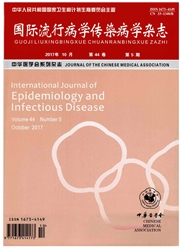

 中文摘要:
中文摘要:
目的了解舟山群岛各县区流行的新布尼亚病毒的基因同源性。方法采集舟山群岛不同县区5例发热伴血小板减少综合征(SFTS)重症或死亡患者的急性期血清,用Veto细胞分离培养毒株,采用RT-PCR扩增所获毒株L、M、S特异性基因节段,使用DNAStar和MEGA5.2软件进行同源性分析并构建系统进化树。结果5株发热伴血小板综合征病毒(SFTSV)的L、M、S基因序列可分成3个进化分支。第一分支毒株全基因序列与韩国JP系列毒株及日本SPL004A有较高同源性,核苷酸相似度在97.8%;第二分支与临近内陆地区部分毒株和日本的部分毒株序列(SPL057A)均有高度同源性,核苷酸相似度均在98.8%-99.9%;第三分支毒株与来源于江苏(JS2007-1等)、辽宁(LN3/2010)、河南(wCH-97/2011)、安徽(AH15/2010)、河南淮阳山(2010-FQM)、湖北(HB2014-20)有较高同源性,核苷酸相似度在97.8%-98.5%。结论舟山群岛内流行的SFTSV同源性不一,存在韩国.舟山、中国其他地区.舟山传播路径可能性。
 英文摘要:
英文摘要:
Objective To understand gene homology of novel Bunyavirus prevailing among counties in Zhoushan Islands. Methods Serums in acute phase were collected from severe fever with thrombocytopenia (SFTS) patients and the viruses were cultured and isolated using Vero cell. Specific gene segments of strain (L, M and S) were amplified by RT-PCR, and sequence homology and phylogenetic analysis were carried out by software DNA Star and MEGAS.2. Results The L, M, S gene sequences of 5 SFTS virus strains could be clustered into 3 clades: the first clade complete gene sequence had relatively high homology with Korean JP series and Japanese SPL004A strains, of which the nucleotide similarity was 97.8% ; the second clade had higher homology with part strains close to inland area and Japanese strain (SPL057A), of which the nucleotide similarity was 98.8%-99.9%; and the third clade had relatively high homology with strains from Jiangsu (JS2007-1, etc.), Liaoning (LN3/ 2010), Henan (WCH-97/2011), Anhui (AH15/2010), Henan Huaiyangshan (2010-FQM) as well as Hubei (HB2014-20), of which the nucleotide similarity was 97.8%-98.5%. Conclusions The homology of SFTS virus prevailing in Zhoushan Island is varied. New evidence supports that SFTS virus isolates in Zhoushan Islands are probable transmitted from South Korea and other partsin mainland China.
 同期刊论文项目
同期刊论文项目
 同项目期刊论文
同项目期刊论文
 期刊信息
期刊信息
